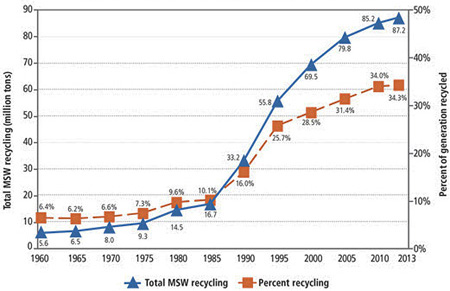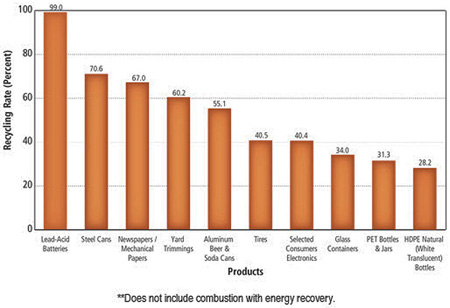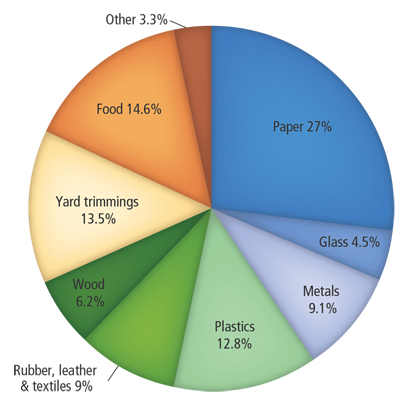Municipal Solid Waste
Related Links
Municipal Solid Waste (MSW)—more commonly known as trash or garbage—consists of everyday items we use and then throw away, such as product packaging, grass clippings, furniture, clothing, bottles, food scraps, newspapers, appliances, paint, and batteries. This comes from our homes, schools, hospitals, and businesses.
Each year EPA produces a report called Advancing Sustainable Materials Management: Facts and Figures 2013, formerly called Municipal Solid Waste in the United States: Facts and Figures. It includes information on MSW generation, recycling, and disposal.
After 30 years of tracking MSW, the report has been expanded to include additional information on source reduction (waste prevention) of MSW, information on historical landfill tipping fees for MSW, and information on construction and demolition debris generation, which is outside of the scope of MSW.
The new name also emphasizes the importance of sustainable materials management (SMM). SMM refers to the use and reuse of materials in the most productive and sustainable ways across their entire life cycle. SMM practices conserve resources, reduce wastes, slow climate change and minimize the environmental impacts of the materials we use.
In 2013, Americans generated about 254 million tons of trash and recycled and composted about 87 million tons of this material, equivalent to a 34.3 percent recycling rate. On average, we recycled and composted 1.51 pounds of our individual waste generation of 4.40 pounds per person per day (Figure 1 and Figure 2).
EPA encourages practices that reduce the amount of waste needing to be disposed of, such as waste prevention, recycling, and composting.
 + View information in text format + View enlarged image |
 + View information in text format + View enlarged image |
 Mechanical papers include directories, newspaper inserts, and some advertisement and direct mail printing. + View information in text format + View enlarged image |
- Source reduction, or waste prevention, is designing products to reduce the amount of waste that will later need to be thrown away and also to make the resulting waste less toxic.
- Recycling is the recovery of useful materials, such as paper, glass, plastic, and metals, from the trash to use to make new products, reducing the amount of virgin raw materials needed.
- Composting involves collecting organic waste, such as food scraps and yard trimmings, and storing it under conditions designed to help it break down naturally. This resulting compost can then be used as a natural fertilizer.
In 2013, newspapers/mechanical papers recovery was about 67 percent (5.4 million tons), and about 60 percent of yard trimmings were recovered (Figure 3). Organic materials continue to be the largest component of MSW. Paper and paperboard account for 27 percent and yard trimmings and food account for another 28 percent. Plastics comprise about 13 percent; metals make up 9 percent; and rubber, leather, and textiles account for 9 percent. Wood follows at around 6 percent and glass at 5 percent. Other miscellaneous wastes make up approximately 3 percent of the MSW generated in 2013 (Figure 4).
This section describes the requirements for disposal and combustion of Municipal Solid Waste:
- Landfills are engineered areas where waste is placed into the land. Landfills usually have liner systems and other safeguards to prevent polluting the groundwater.
- Energy Recovery from Waste is the conversion of non-recyclable waste materials into useable heat, electricity, or fuel.
- Transfer Stations are facilities where municipal solid waste is unloaded from collection vehicles and briefly held while it is reloaded onto larger, long-distance transport vehicles for shipment to landfills or other treatment or disposal facilities.
Resource Conservation
Recycling and composting prevented 87.2 million tons of material away from being disposed in 2013, up from 15 million tons in 1980. This prevented the release of approximately 186 million metric tons of carbon dioxide equivalent into the air in 2013—equivalent to taking over 39 million cars off the road for a year. Learn more about how common wastes and materials, including food and yard wastes, paper, metals, and electronics, contribute to MSW generation and how they can be recycled.
|
 Figure 4. Total MSW Generation (by Material), 2013 254 Million Tons (before recycling) + View information in text format + View enlarged image |
![[logo] US EPA](../gif/logo_epaseal.gif)